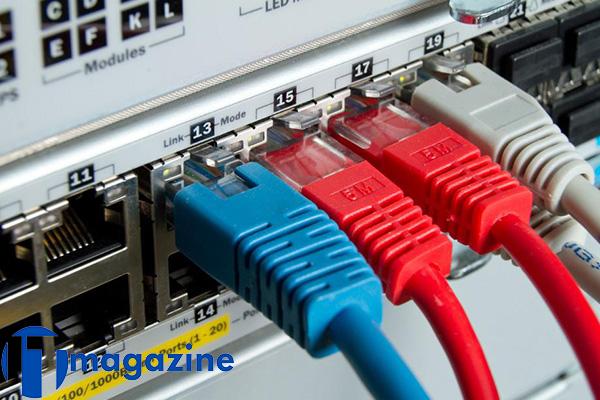The coating material of network cables is one of the main differences between indoor and outdoor cables. In this article, it examines the difference between indoor and outdoor network cables in detail and by comparing indoor and outdoor cables, it provides explanations of the use of indoor and outdoor network cables. With the introduction of playground cables that can be installed underground, it goes to indoor and outdoor cables that have ratings. It also examines the reasons for using the cat6 category in indoor and outdoor network cables and examines their uses in a special way.
Outdoor network cable
If the cable is exposed to elements such as sunlight, moisture, weather, and sudden temperature changes, a cable with a grade and rating should be used. Whether it is a network cable or a fiber cable, etc., in any case, according to the environmental factors, cables suitable for the same environment should be used. In spaces such as parking lots or spaces that have a roof, outdoor cables should be used with ratings suitable for the same environment. The outdoor network cable has a waterproof tape to protect against moisture and water. In case of water penetration, this layer protects the cable.
Indoor network cable
Installing indoor network cable in residential and office buildings that are not exposed to external elements is very suitable. Outdoor cables are more expensive due to the type of protection level. Internal cables come with easy and cheaper installation.
Cables are not necessarily made for outdoor use. The difference between indoor and outdoor network cable is related to their location in the open space. Failure to pay attention to this structure leads to long-term failure in the cable. To avoid this failure, the following points should be taken into account:
- Use a pipe or a channel to protect the cat5e /cat6 cable in outdoor conditions so that they are buried underground to avoid electrical interference from other sources. The individual electrical conductors inside the cable are placed in an insulating sheath of solid thermoplastic or PVC, which blocks the entry of moisture and protects the conductors.
- To save money and pipes, it is better to use some rated outdoor cables and protect them with waterproof adhesive tape.
- Graded cables are made to resist heat and UV rays, and their UV resistant sheaths are made of UV resistant PE or PVC materials.
The difference between indoor and outdoor cable
The main difference between these two indoor and outdoor cables is their outer cover. The coating that covers the outdoor cable is graded according to the changes in weather and temperature in the outdoor space. For example, the 6 cat cable can be used in both spaces. It is resistant to temperature changes in the open space with the grading feature. Cat 6 cable is also UV resistant. In short, it should be said that 6 cat network cables are resistant to environmental elements due to their stronger cover and can be installed underground. Indoor cables are designed for short distances such as office buildings and factories. Outdoor network cable can be used in humid residential places. The price of indoor cables is cheaper.

Comparison of indoor and outdoor network cables
The outer layer of the outdoor network cable is thicker than the inner layer of the cable. A PE waterproof layer has also been added to it, so that they are more resistant to tension and pressure during wiring and do not damage the copper core. Outdoor network cable must be resistant to temperature fluctuations. If the outer sheath of the outdoor network cable is not good, it is easily damaged and cannot be used in the network. It should be noted that the cost of using external cables is higher and this amount of cost often depends on the protection measures taken.
The indoor network cable passes over the building wall in short distances and is less damaged. It should be noted that during internal network cabling, do not use too much force to pull the wires, because it damages the core of the wires. Don’t forget to take care of the outer shell of the indoor network cable. It is better to use the trunk for building. The indoor network cable in the industry pays attention to the quality and stability of the connection. The indoor network cable is designed for short connections inside the building. It is recommended that the indoor network cable is not used in the game space. The requirement to use these cables in the open space is to be buried underground.
What is meant by rated indoor network cable?
Ordinary cables are not suitable and resistant to the conditions and changes of nature. The rated cable is used when the network cable must be installed outside. Indoor cables are usually made with conventional PVC (polyvinyl chloride) sheaths, which have no UV protection and the sheaths are fragile. They easily crack under direct sunlight and deteriorate over time. There are cables in the market that are graded and cables that do not need a channel and are placed directly underground without any pipes or channels. Their design is such that these cables do not need protection, as they have ratings and features that protect them from external elements.
Introducing outdoor cables that can be installed underground
These cables have a PVC cover and are used as outdoor cables. This feature protects the internal cable and is widely used in external wiring. This cover is suitable for moisture under the soil and prevents moisture damage. Some of these cables use a special coating to prevent them from being chewed by rodents. These cables are divided into three main categories:
- A cable that has a waterproof gel covers the cracks and gaps of the internal wires. This feature prevents water penetration.
- The second type has a waterproof tape that covers the internal wiring. Protects the cable from water and moisture.
- The third type is usually found in shielded cable and protects the inner wires with a strip of polyester-like material.
The difference between rated cables and cables that can be installed underground
The degree of resistance against the elements of nature is important in rated cables. According to the amount of resistance, any cable is rated for outdoor use. These cables are resistant to sunlight with a special coating and are not easily broken or destroyed over time. These cables are made of polyethylene PE coating and are resistant to cold up to 20 degrees Celsius. Another type of cable that is placed directly in the soil is buried in the soil without using a special channel or conduit. These cables are designed from PE or PVC materials and UV resistant materials.
Introducing several types of cables that can be installed underground
Different types of these types of cables are available in the world market. In the rest of the article, it briefly introduces a few cases.
- FTP cable impregnated with a type of gel for added protection: they have a UV resistant LPDE coating to protect against water penetration. Gel coated cat5e cables are offered for added protection against soil elements such as water and humidity.
- Shielded FTP cable: Uses water-resistant adhesive tape that absorbs moisture. These cables, which are protected by aluminum foil, have an LSZH coating. They are resistant to sunlight and temperature changes. Cat5e and cat6 cables are also used in these cases.
- Gel-impregnated UTP cable: outdoors against UV rays, in addition to having an LSZH coating, it has a wrapped layer and an additional screw tape that is placed directly in the ground.
- cat5e cable with gel: In addition to 23 AWG solid conductors, it has a UV-resistant LSZH coating and is impregnated with gel and has a tape fastening for laying in the ground.
Using Cat6 cable as an indoor network cable
Since Cat6 cables are the more advanced generation of this series with better connectivity, they are used. Although these cables are used in residential places, they are more common in industrial or commercial facilities.
Using Cat6 as an outdoor network cable
Due to the cable coating that is resistant to changes in temperature, humidity, and ultraviolet rays, Cat6 cable can be used outdoors. But it is better to install it underground. Because it has more strength. These cables are resistant to sunlight. They offer high speed data transfer. It transmits up to Gigabit Ethernet between buildings and between external devices such as ATMs. They are also applicable for phone line programs. The use of waterproof tape is also suitable for protecting the cat 6 cable when it is placed underground. One of the best outdoor solutions is Cat6 UTP for direct underground installation.
general idea
The most important principle in choosing indoor and outdoor network cables is their performance security. In this article, as a guide, it examines the differences between indoor and outdoor network cables and provides guidelines for using rated cables and outdoor network cables that can be installed underground. One of the best cat6 network cables is also recommended in this article for both indoor and outdoor spaces.











Comment here